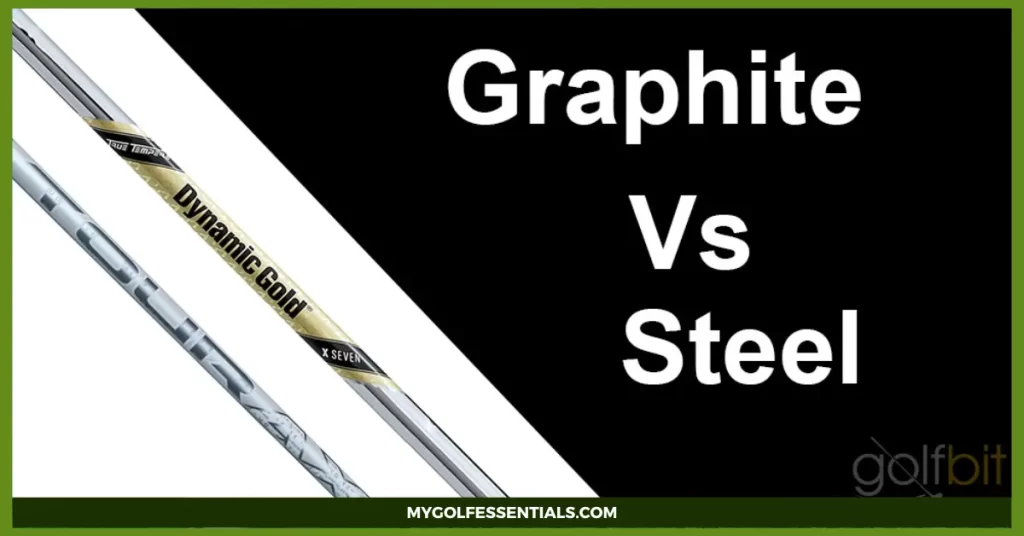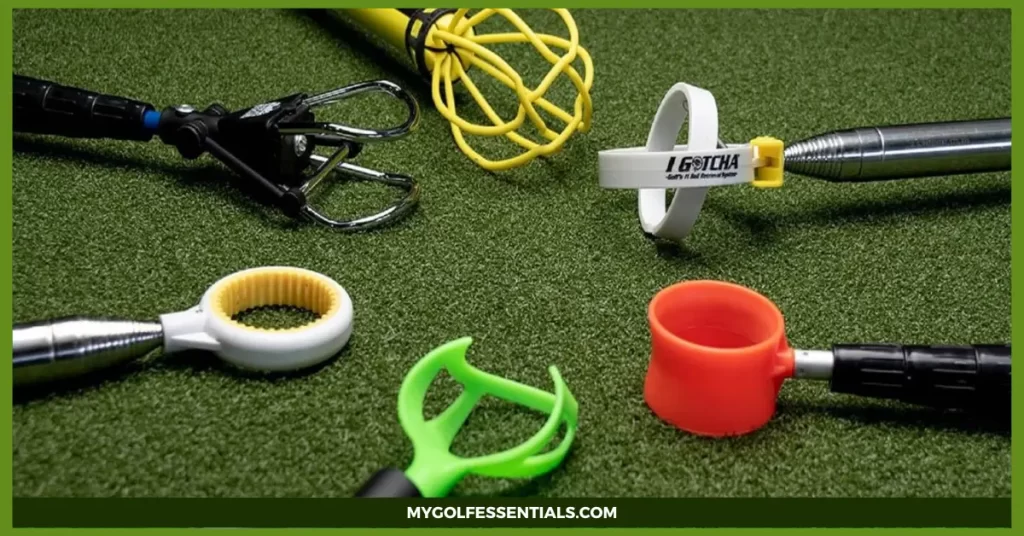
Trying to determine whether graphite or steel shafts are the best choices for your golf clubs? It can be a tough decision. Both offer unique benefits and drawbacks, so there is no single answer. In this blog post, we’ll provide information on both types of shafts and explore their relative advantages in depth. We’ll also take an honest look at how they could potentially impact your performance on the course, providing insight into which one might suit you best. Ready to learn more? Let’s dive in!
Overview of Graphite and Steel Shafts

Golf shafts are an essential component of any golf club and come in various materials, with graphite and steel being two of the most popular options. Each has distinctive properties that make it better suited for certain players. Before selecting either type, it is important to understand their differences and how they can affect performance on the course.
Graphite Shafts

Graphite shafts are lighter than steel shafts, making them less taxing on the golfer’s body during a round of golf. This also results in more club head speed and distance off the tee. Conversely, graphite shafts can sacrifice some accuracy due to increased flexing throughout the swing.
Steel Shafts

Steel shafts are heavier than graphite shafts, making them more suitable for players who want maximum control over their shots. They also provide a better feel on impact and offer far greater accuracy due to less flexing throughout the swing. On the downside, steel shafts can be harder on a golfer’s body due to the extra weight, leading to fatigue throughout a round.
In summary, graphite and steel shafts offer distinct benefits and drawbacks. Ultimately, it comes down to personal preference and what type of performance the golfer is after. Whether looking for added distance or greater accuracy, understanding how both materials differ can make all the difference when selecting a golf shaft.
Benefits of Graphite vs. Steel Shafts

Each material has some benefits when choosing between graphite and steel shafts. Graphite shafts are lighter than steel shafts, providing higher swing speeds with less effort. This can benefit golfers with a slower swing speed or those wanting to increase their distance off the tee.
Graphite shafts are also more flexible than steel shafts, which absorb more impact when hitting a ball. This can improve accuracy and control for golfers who tend to ‘slice’ or ‘hook’ the ball off the tee.
On the other hand, steel shafts offer increased performance but require more effort from the golfer. Steel shafts are more rigid, meaning the golfer must generate a greater swing speed to achieve the desired performance. Steel shafts are also less expensive than graphite, making them an attractive option for those who don’t want to invest heavily in golf clubs.
It is up to personal preference when choosing a shaft type. Graphite and steel have advantages and disadvantages, so weigh all the pros and cons before deciding.
Differences between Graphite Shafts and Steel Shafts
When deciding which type of golf shaft is best for you, it can be helpful to understand the differences between graphite and steel shafts. Graphite has become increasingly popular, but steel still retains a place among avid golfers.
The main difference between graphite and steel is their composition: graphite is lightweight and flexible, while steel is heavier and stiffer. Graphite shafts are easier to swing than steel shafts because they have less momentum. This makes them ideal for slower swingers who want to increase their clubhead speed without exerting too much effort.
Another difference between graphite and steel is how they affect ball spin rate. Steel shafts produce more spin on your shots, while graphite reduces spin. Many golfers opt for a graphite shaft if they have difficulty controlling their ball flight.
Factors to Consider when Choosing Between Graphite and Steel Shafts

When selecting the right golf shaft for your clubs, there are various factors to consider. While graphite and steel shafts offer distinct advantages and disadvantages, there is no definitive answer as to which type of shaft is superior. To make an informed decision, you should weigh the pros and cons of each material in terms of performance, feel, flex, and price.
Performance: Graphite shafts are generally lighter than steel shafts, allowing players to generate more clubhead speed for added distance off the tee. However, some golfers may find graphite too flexible for their swing, resulting in losing control. Steel shafts may be better if you prefer a stiffer feel and greater accuracy over additional distance.
Feel: The feel of your golf club is largely determined by the flex and weight of the shaft. Most players agree that graphite can provide a softer, more responsive feeling thanks to its lighter weight. On the other hand, steel shafts typically offer a firmer, more solid sensation due to their greater stiffness and heavier construction.
Flex: Flex measures how much the shaft bends during your swing, affecting your ball flight. Steel shafts tend to be stiffer with less flexibility than graphite, offering players greater control over their shots. However, graphite may be better if you need more help generating power and distance off the tee box.
Price: graphite iron shafts are usually more expensive than steel, but the graphite shafts cost difference diminishes as graphite technology improves. While steel shafts may be cheaper initially, you should also consider the potential long-term savings that a lighter, more durable graphite shaft can provide.
Does Tiger Woods use steel or graphite shafts?
The answer to this question is both! Depending on the situation, professional golfers, such as Tiger fairway woods, may use graphite or steel shafts. Graphite and steel are two of the most widely used materials in golf shafts, and each has unique advantages and disadvantages.
Graphite shafts can offer increased distance because their lighter weight allows faster clubhead speed and higher launch angle. Additionally, graphite shafts are more flexible than steel shafts which can provide a better feel and accuracy. However, graphite shafts are more expensive than steel and can be more susceptible to breaking if not properly handled.
Steel shafts offer greater control because they have a firmer feel and provide more consistent ball flight. Steel shafts are also more durable than graphite and less expensive, but they can be much heavier, which can slow down clubhead speed and cause fatigue in the golfer’s hands if not balanced properly.
Pros And Cons of Graphite Shaft

Graphite shafts are becoming increasingly popular among golfers due to their lighter weight and increased accuracy. Graphite shafts are made from a composite material that is much lighter than steel, making them easier to swing with more control and accuracy. They also offer higher ball speeds, greater distance when hit properly, and an improved feel for shots around the green.
Pros:
– Lighter weight: Graphite shafts are significantly lighter than steel, allowing for greater swing speed.
– Increased accuracy: The lighter weight of graphite shafts helps to increase accuracy by reducing the amount of torque in a swing.
– Greater distance: Thanks to their higher ball speeds and improved feel, graphite shafts help golfers hit the ball farther.
– Improved feel: The composite material of graphite shafts helps to reduce vibration, resulting in soft and smooth shots around the green.
Cons:
– Expense: Graphite shafts are more expensive than steel ones.
– Shaft breakage: Due to their lighter weight, graphite shafts can be more prone to breakage.
– Swing speed inconsistency: Graphite shafts can be difficult to keep consistent with swing speeds since they are so light and more sensitive to changes in tempo.
– Damage from heat: Graphite shafts are less heat resistant than steel ones and can warp or break if exposed to extreme temperatures.
Pros And Cons of Steel Shaft
The primary advantage of steel shafts is that they are often more durable and effective than graphite. Steel shafts tend to offer greater control over the shot direction and accuracy and provide an overall better feel in the hands of a golfer.
Pros:
– More durable and reliable than graphite shafts
– Great control over shot direction and accuracy
– Improved feel in the hands of a golfer
Cons:
– Steel shafts can be heavier than graphite, making them unsuitable for some golfers who need lighter clubs to maximize their swing speed.
– Steel shafts are more expensive than graphite shafts.
When should I switch to graphite shafts?
Graphite shafts are much lighter compared to steel, and therefore, they generate more clubhead speed. Consequently, golfers with slow swing speeds can benefit from graphite shafts since the additional clubhead speed will help them hit the ball farther off the tee. Graphite shafts also offer a greater feel, benefiting players who want to improve their accuracy.
However, if you have a fast swing speed and can hit the ball far enough, steel shafts may still benefit you. Steel shafts are extremely durable and will last longer than graphite shafts. Furthermore, steel shafts offer more control over your shots since they provide greater stability through impact with the ball.
Ultimately, the choice of shaft material is based on what you are trying to achieve with your game and the type of golf equipment that best suits your swing. If you are a golfer struggling to generate enough clubhead speed, switching to graphite shafts will likely benefit you. On the other hand, if you already have a fast swing speed and are looking for greater control, steel shafts might be a better option.
Weight Differences Between the Two Materials
The main difference between graphite and steel shafts is weight. Graphite shafts generally weigh less than steel, which allows golfers to swing the club faster without sacrificing control or accuracy. It also makes it easier to generate more clubhead speed, which can result in improved distance off the tee. Graphite is lighter because it is a composite material made from carbon and other synthetic components. On the other hand, steel is a single material with more weight.
How to Choose the Right Shaft for Your Game
When it comes to golf clubs, the shaft is an essential component. There are two main types of shaft materials: graphite and steel. Both offer distinct advantages, so here’s a brief guide to help you decide which is best for your game.
Graphite shafts are lighter and typically more flexible than steel, making them ideal for players with slower swing speeds. They also absorb more shock and vibration, resulting in a softer feel, benefiting players with elbow or wrist pain. Additionally, graphite shafts are generally less expensive than steel shafts.
Steel shafts tend to provide more control and accuracy, as they don’t flex as easily as graphite shafts. Steel is typically heavier than graphite and produces a firmer feel. Steel shafts can also be more durable over time. However, they tend to cost more than graphite.
Tips for getting the most out of your chosen shaft type
Graphite and steel are two of the most popular options when choosing the right golf shaft for your game. While each type of shaft offers its unique benefits, there are some tips you can use to get the most out of either option.
For flex graphite shafts, one of the best things you can do is make sure that you choose a shaft that fits your swing speed. Graphite shafts are designed to flex according to the speed of the golfer’s swing, so getting one with the right stiffness is important. You won’t benefit if your swing is too fast or slow for a particular shaft.
When using a steel shaft, it’s important to remember that steel is less flexible than graphite. Therefore, you should avoid taking big swings with your club unless you are confident in your ability and know you can control the golf ball. This will help ensure that the shaft doesn’t twist or bend too much, which could affect accuracy and distance.
FAQs
How do graphite and steel shafts compare?
Graphite golf shafts are typically lighter than steel shafts, allowing for greater club-head speed and distance. On the other hand, steel shafts tend to be more consistent in their flex throughout the swing, providing better control over shot shape and accuracy. In addition, because of its weight and stiffness, steel and graphite shafts are a better choice for players with slower swing speeds.
What are the advantages of graphite shafts?
Graphite shafts offer some benefits, including greater distance and flexibility. They typically feature more “feel” than steel shafts due to their lighter weight and flexibility.
What are the advantages of steel shafts?
Steel golf shafts offer better control over the accuracy and shot shape due to their stiffness and consistent flex throughout the swing. Steel iron shafts are also better for players with slower swing speeds due to their weight and stiffness.
What factors should I consider when choosing between graphite or steel shafts?
When deciding between graphite irons and steel golf shafts, there are a few key factors to consider. The first is your swing speed – if it’s low, steel shafts may be the better option due to their weight and stiffness.
Conclusion
I hope this article has helped me understand the differences between graphite and steel shafts. Both materials offer unique advantages and disadvantages that should be considered before purchasing.
Graphite shafts are typically lighter, more flexible, and provide less shock to the user than steel shafts. On the other hand, steel is generally more durable, performs consistently, and provides better control than graphite.



